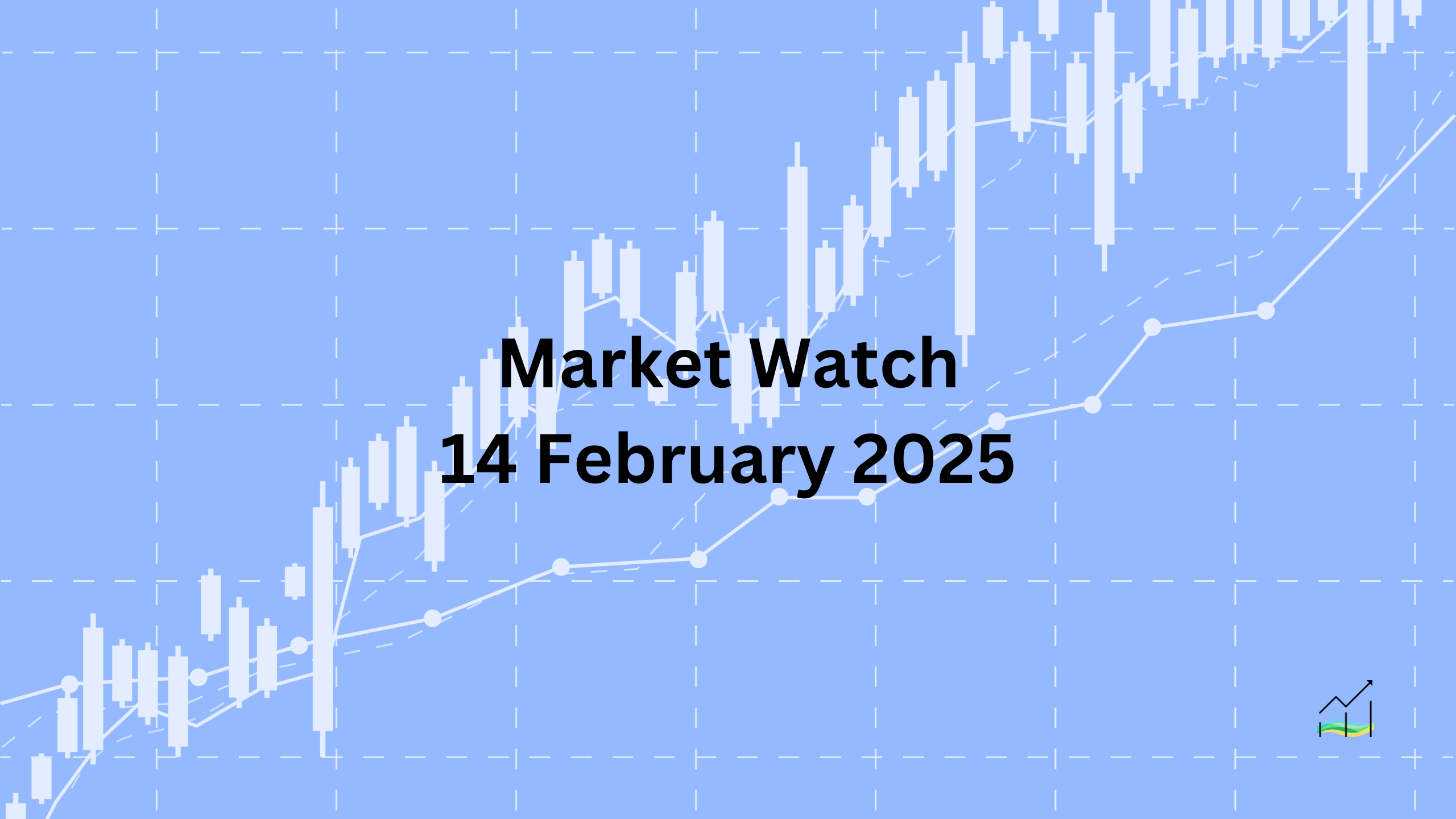14/02/2025 Market Watch

Markets Absorb U.S. Tariff Plans as Dollar Weakens
The announcement of US reciprocal tariffs had minimal impact on global markets, as seen in the ongoing equity rally and a slightly weaker dollar. The measured market reaction is largely due to the complexity of the proposed tariff measures and their delayed implementation, allowing time for negotiations.
The dollar's selloff has accelerated toward the end of the week, driven by evolving trade policy signals from the White House. Wall Street saw broad gains overnight, as markets took comfort in the fact that the new tariff plans do not impose immediate restrictions. Instead, the US administration will conduct a detailed review of tariff disparities before determining specific actions.
Despite optimism in US equities, risk-on sentiment has not fully carried over into Asia. Hong Kong stocks extended their strong gains, but other major indexes showed mixed performance, reflecting investor caution. Markets remain on edge as the US trade team begins assessing trade imbalances, a process expected to take weeks and introduce further volatility.
Attention now turns to US retail sales data for January, which will offer insights into consumer spending. However, even a major surprise is unlikely to shift Federal Reserve expectations. The Fed has emphasized that its decisions will be guided by sustained economic trends rather than single data points. As a result, the dollar remains under pressure, while risk assets continue to gain favor.
Among major currencies, the New Zealand dollar is leading, supported by unexpectedly strong manufacturing data. The economy is responding well to last year’s aggressive rate cuts by the RBNZ. While another 50bps rate reduction is expected next week, the manufacturing recovery suggests that the central bank may not need to push rates further into stimulatory territory.
Asian markets showed mixed performance at the time of writing. The Nikkei fell by 0.35%, while Hong Kong’s HSI rose 2.48%. China’s SSE gained 0.25%. In bonds, Japan’s 10-year JGB yield climbed slightly to 1.351. Overnight, US equities saw strong gains, with the Dow up 0.77%, the S&P 500 rising 1.04%, and the Nasdaq climbing 1.50%. Meanwhile, the 10-year Treasury yield eased to 4.525%.
United States of America
Overview
The US dollar is slightly weaker in Europe today, pressured by lower US interest rates, optimism surrounding a potential resolution to the Ukraine war, and uncertainty over the latest reciprocal tariff measures. Markets had expected a major trade report from the Commerce Department in April, followed by tariff decisions. However, there were concerns that this week’s announcement could introduce immediate tariffs. The news that it primarily sets the stage for the April report has eased market fears.
Economic Drivers
The US administration's approach to reciprocal tariffs involves a complex assessment of multiple economic factors, including import tariffs, VAT rates, subsidies, regulatory burdens, and FX misalignment. The Commerce Department is tasked with producing a detailed country-by-country report by April, but how feasible this is remains uncertain given ongoing government workforce reductions.
The EU is expected to be a primary target, with the US using tariff threats as leverage against the EU’s digital service tax. If aggressive tariffs are imposed, they could significantly impact trade relations. However, market expectations have already factored in peak trade pressures for Q2, suggesting that the dollar’s recent weakness is likely a temporary correction rather than a major trend shift.
Data and Events
Investors are closely watching the Munich Security Conference, where discussions could influence geopolitical risk sentiment. Speculation is growing about possible high-level negotiations involving the US, Russia, Ukraine, and European representatives in Saudi Arabia.
Additionally, US retail sales data for January is due, but any weakness in the report is expected to have a limited impact on the dollar, given its likely weather-related distortions.
Price Action
The dollar index (DXY) is testing key support levels at 106.95/107.00, with a potential move lower toward 106.35. Short-term momentum suggests continued softness in the dollar, though a broader trend reversal is not yet evident.
Key Points:
- The dollar is weaker due to lower US interest rates and uncertainty around tariffs.
- Reciprocal tariffs remain complex, with a full assessment expected by April.
- The EU is a primary target for US trade pressure, particularly regarding digital service taxes.
- Market expectations suggest peak trade tensions in Q2, supporting a dollar rebound later.
- Investors are monitoring geopolitical developments at the Munich Security Conference.
- US retail sales data is unlikely to have a significant impact on the dollar.
Europe
Overview
EUR/USD strengthened as US interest rates fell following a softer-than-expected US Producer Price Index (PPI) report, which signals a muted impact on the core PCE deflator. Additionally, relief that new US tariffs were not immediate has given trading partners time to adjust their strategies, contributing to near-term dollar softness.
Despite this, the broader trend remains uncertain. While discussions continue on whether capital rotation into European equities could support the euro, there are no clear signs of significant inflows into key eurozone equity ETFs.
Economic Drivers
The US tariff approach remains a key market focus, with trading partners weighing their responses, including increasing US LNG purchases, reducing trade barriers, or maintaining a defensive stance. Markets are also pricing in approximately 81 basis points of ECB rate cuts by the end of 2025, reinforcing expectations of a widening yield differential between the ECB and the Fed.
Data and Events
Today's Eurozone GDP release is expected to show flat (0.0% QoQ) growth, which could reinforce concerns about stagnation. This data will be pivotal in shaping market sentiment on future ECB policy moves.
Price Action
EUR/USD is correcting higher, with the 1.0535/75 range seen as the potential upper limit for the current move before resuming a broader downtrend. Support at 1.0340 remains critical—holding above this level could suggest further upside. However, resistance at 1.0444 and 1.0521 is expected to limit gains.
Key Points:
- EUR/USD gains as US PPI data signals softer inflation pressure.
- Market relieved by the delay in US tariff measures.
- ECB rate cut expectations continue to weigh on the euro.
- Eurozone GDP release could reinforce stagflation concerns.
- EUR/USD correction likely capped at 1.0535/75 before resuming a downtrend.
Japan
Overview
USD/JPY weakened, erasing the previous day’s gains, as US Treasury yields retreated. The 2-year yield approached 4.30%, while the 10-year yield dropped below 4.55%. Heavy selling in the Asian and European sessions, including notable institutional activity, pushed the pair below the key technical level of 154.22.
Economic Drivers
The decline in US yields reduced the dollar’s appeal, contributing to USD/JPY’s downside movement. Despite stronger US PPI data, dollar bulls appeared to lose momentum, reflecting broader market hesitation on further upside potential.
Data and Events
Market focus remains on US Treasury yield movements and upcoming economic data, which could influence USD positioning. Any unexpected shifts in inflation expectations or Fed policy outlooks could further impact the pair’s direction.
Price Action
USD/JPY is testing critical support at the 200-day moving average (152.74), with the next major support zone between 151.50 and 152.00. Resistance now stands at 155.00, and a breakdown below the 200 MA could trigger further weakness.
Key Points:
- USD/JPY dropped as US Treasury yields declined.
- Institutional selling during Asian and European sessions intensified the move.
- Stronger US PPI failed to support the dollar.
- Key support lies at 152.74, with further downside potential if broken.
- Resistance now set at 155.00, capping any near-term rebounds.
New Zealand
Overview
New Zealand’s manufacturing sector showed signs of recovery in January, with the BusinessNZ Performance of Manufacturing Index (PMI) rising from 46.2 to 51.4. This marks the first expansion in nearly two years and the highest reading since September 2022. However, despite the improvement, the index remains below its long-term average of 52.5, indicating the sector has yet to regain full momentum.
Economic Drivers
The broad-based recovery saw all key sub-indexes move into expansionary territory. Production increased from 42.7 to 50.9, while employment rose to 50.2 from 47.7. New orders improved significantly to 50.9, alongside gains in finished stocks (51.9) and deliveries (51.7).
Data and Events
The latest PMI release signals a shift in momentum for New Zealand’s economy after a prolonged period of contraction. Analysts view the return to expansion as a positive step, though caution remains as the index is still below historical norms.
Price Action
While the manufacturing recovery is encouraging, the data is unlikely to significantly impact NZD movements unless further improvements are sustained. Markets will closely watch upcoming economic reports to gauge whether this rebound signals a broader trend.
Key Points:
- New Zealand’s PMI jumped to 51.4 in January, ending a 23-month contraction.
- All major sub-indexes moved into expansion.
- Production, employment, and new orders showed notable gains.
- The index remains below its long-term average of 52.5, signaling incomplete recovery.
- Market reaction to the data has been limited, with further reports needed for confirmation.
United Kingdom
Overview
GBP/USD saw a sharp move higher, breaking above the 50-day moving average (1.2470) as stronger-than-expected UK data and a softer dollar fueled bullish momentum. The pair ended the session above 1.2540, reflecting a risk-on sentiment.
Economic Drivers
UK Q4 GDP unexpectedly grew by 0.1% QoQ, avoiding the anticipated contraction. This positive surprise provided support for the pound, reinforcing near-term upside potential. However, the broader outlook remains cautious, as the UK’s slower economic growth relative to the US could limit long-term gains.
Data and Events
With no major UK economic releases scheduled today, further upside may be limited. The lack of fresh catalysts could see GBP/USD consolidate rather than extend gains.
Price Action
If GBP/USD holds above 1.2400, further upside toward 1.2576 and 1.2600 is possible. However, technical indicators suggest overbought conditions, increasing the risk of a pullback toward the 50-day moving average.
Key Points:
- GBP/USD broke key resistance at 1.2470, closing above 1.2540.
- UK Q4 GDP unexpectedly expanded by 0.1% QoQ, avoiding a contraction.
- Limited UK data today may cap further upside momentum.
- Holding above 1.2400 keeps the bullish outlook intact, with targets at 1.2576 and 1.2600.
- Overbought conditions suggest a potential short-term reversal toward the 50 MA.
© 2025 SKONE Enterprise (003319453-V). All rights reserved.
The content on this site is for informational purposes only and does not constitute financial advice.


